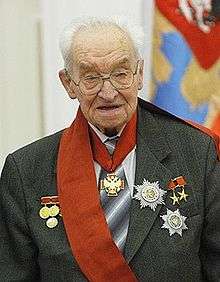Vladimir Kotelnikov

Vladimir Aleksandrovich Kotelnikov (Russian Владимир Александрович Котельников, scientific transliteration Vladimir Alexandrovič Kotelnikov, 6 September 1908 in Kazan – 11 February 2005 in Moscow) was an information theory and radar astronomy pioneer from the Soviet Union. He was elected a member of the Russian Academy of Science, in the Department of Technical Science (radio technology) in 1953. From 30 July 1973 to 25 March 1980 Kotelnikov served as Chairman of the RSFSR Supreme Soviet.
Career timeline
- 1926-31 study of radio telecommunications at the Bauman Moscow State Technical University and Moscow Power Engineering Institute, dissertation in engineering science.
- 1931-41 worked at the MEI as an engineer, scientific assistant, laboratory director and lecturer.
- 1941-44 worked as developer in the telecommunication industry.
- 1944-80 full professor at the MEI.
- 1953-87 deputy director and since 1954 director of the Institute of Radio-engineering and Electronics of the Russian Academy of Science (IRE RAS).
- 1964 Lenin Prize [1]
- 1970-88 vice-president of the RAS; since 1988 adviser of the presidium.
Achievements
He is mostly known for having discovered, before e.g. Edmund Whittaker, Harry Nyquist, Claude Shannon, the sampling theorem in 1933. [2] This result of Fourier Analysis was known in harmonic analysis since the end of the 19th century and circulated in the 1920s and 1930s in the engineering community. He was the first to write down a precise statement of this theorem in relation to signal transmission. He also was a pioneer in the use of signal theory in modulation and communications.
He is also a creator of the theory of optimum noise immunity.[3] He obtained several scientific prizes for his work in radio astronomy and signal theory. In 1961, he oversaw one of the first efforts to probe the planet Venus with radar. In June 1962 he led the first probe of the planet Mercury with radar.[4][5][6]
Kotelnikov was also involved in cryptography, proving the absolute security of the one-time pad; his results were delivered in 1941, the time of Nazi Germany's invasion of the Soviet Union, in a report that apparently remains classified.[7] In this, as with the above-mentioned sampling theorem, he and Claude Shannon in the US reached the same conclusions independently of each other. For his achievements Kotelnikov was awarded the IEEE 2000 Gold Medal of Alexander Graham Bell and the honorable IEEE Third Millennium Medal. Prof. Bruce Eisenstein, the President of the IEEE, described Kotelnikov as follows: "The outstanding hero of the present. His merits are recognized all over the world. In front of us is the giant of radio engineering thought, who has made the most significant contribution to media communication development".
Honours and awards
- Order of Merit for the Fatherland;
- 1st class (21 September 2003) - for outstanding achievement in the development of science and many years of fruitful activity
- 2nd class (6 July 1998) - for outstanding service to the state, his great personal contribution to the development of national science and training of highly qualified personnel
- Order of Honour
- Twice Hero of Socialist Labour (1969, 1978)
- Six Orders of Lenin
- Order of the Red Banner of Labour, twice
- Order of the Badge of Honour
- Lenin Prize (1964)
- Two Stalin Prizes (1943, 1946)
- Badge "For Services to Moscow" (26 August 2003) - for outstanding contribution to the development of national science and technology, training of scientific personnel, many years of fruitful activities that promote social and economic development in Moscow
- Prize of the Council of Ministers
- Lomonosov Gold Medal (1981)
- Popov Gold Medal (1974)
- Gold Medal of the Academy of Sciences of the USSR (1987)
- IEEE Award in honor of Hernand and Sosthenes Behn (1973)
- IEEE Alexander Graham Bell Medal (of the USA) (2000)
- Main prize of the International Science Foundation Edward Rhine (Germany, 1999) - for "basic research" which for the first time accurately defined and mathematically proved, in the aspect of communication technology, sampling theorem
- Kotel'nikov's name has been given to asteroid number 2726 (International catalog number 9214),[8] to a naval vessel and to the Institute of Radio-engineering and Electronics.
References
- ↑ Bissel C, "The Sampling Theorem", Communications Engineer, July/July 2007, IET, United Kingdom ISSN 1479-8352
- ↑ Kotelnikov VA, On the transmission capacity of "ether" and wire in electrocommunications, (English translation, PDF), Izd. Red. Upr. Svyazzi RKKA (1933), Reprint in Modern Sampling Theory: Mathematics and Applications, Editors: J. J. Benedetto und PJSG Ferreira, Birkhauser (Boston) 2000, ISBN 0-8176-4023-1
- ↑ Kotelnikov VA, The Theory of Optimum Noise Immunity (monograph), Russia 1956, US 1959
- ↑ Evans, J. V.; Brockelman, R. A.; Henry, J. C.; Hyde, G. M.; Kraft, L. G.; Reid, W. A.; Smith, W. W. (1965). "Radio Echo Observations of Venus and Mercury at 23 cm Wavelength". Astron. J. 70: 487. Bibcode:1965AJ.....70..486E. doi:10.1086/109772.
- ↑ Moore, Patrick (2000). The Data Book of Astronomy. New York: CRC Press. p. 483. ISBN 0-7503-0620-3.
- ↑ chapter 5
- ↑ Sergei N Molotkov (Institute of Solid-State Physics, Russian Academy of Sciences, Chernogolovka, Moscow region, Russian Federation) (22 February 2006). "Quantum cryptography and V A Kotel'nikov's one-time key and sampling theorems". Physics-Uspekhi (Institute of Solid-State Physics, Russian Academy of Sciences, Chernogolovka, Moscow region, Russian Federation) 49 (7): 750–761. Bibcode:2006PhyU...49..750M. doi:10.1070/PU2006v049n07ABEH006050. Retrieved 2009-05-03. PACS numbers: 01.10.Fv, 03.67.Dd, 89.70.+c and openly in Russian Квантовая криптография и теоремы В.А. Котельникова об одноразовых ключах и об отсчетах. УФН
- ↑ Schmadel, Lutz D. (2003). Dictionary of Minor Planet Names, Volume 1. New York: Springer. p. 223. ISBN 3-540-00238-3.
| Wikimedia Commons has media related to Vladimir Kotelnikov. |
| Awards | ||
|---|---|---|
| Preceded by David Messerschmitt |
IEEE Alexander Graham Bell Medal 2000 |
Succeeded by Not awarded (Joachim Hagenauer, 2002) |
|